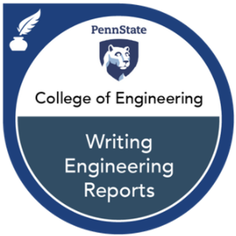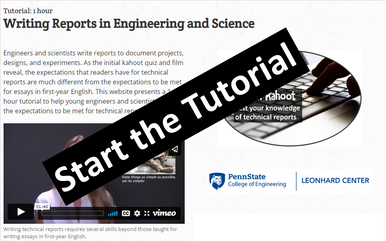Microcredentialing Badge
Writing Engineering Reports:
Understanding Expectations
|
This site presents a digital badge that uses assessments, videos, and other resources to help you understand the expectations on you when writing reports in engineering and science. The badge uses authentic examples from reports written by engineering and science students. After completing this material, Penn State students and our partners can earn a digital badge. A digital badge is a shareable credential that can help you demonstrate your achievements and competencies on your LinkedIn profile, résumé, or e-portfolio.
The badge, which is formally titled “Writing Engineering Reports: Understanding Expectations,” will be awarded if you meet the following criteria:
Badges, which are delivered to the email address you provide on the comprehension quiz, will be awarded within two weeks of scoring enough points on the comprehension quiz.
|
Acknowledgments
This digital badge was made possible by funds provided by the Leonhard Center for the Enhancement of Engineering Education in the College of Engineering at Pennsylvania State University. Providing technical assistance on the films is the Office of Digital Learning, which is also in the College of Engineering at Penn State.
This digital badge was made possible by funds provided by the Leonhard Center for the Enhancement of Engineering Education in the College of Engineering at Pennsylvania State University. Providing technical assistance on the films is the Office of Digital Learning, which is also in the College of Engineering at Penn State.
Role |
Name |
Department |
Institution |
Faculty Editor |
Professor Michael Alley |
College of Engineering |
Penn State |
Film Editor |
Casey Fenton |
Office of Digital Learning |
Penn State |
Film Editor |
Elaine Whitmer |
Office of Digital Learning |
Penn State |
Student Editor, 2022 |
Olivia Brencovich |
Mechanical Engineering |
Penn State |
Website Editor, 2022 |
Marissa Beighley |
Computer Science |
Penn State |


